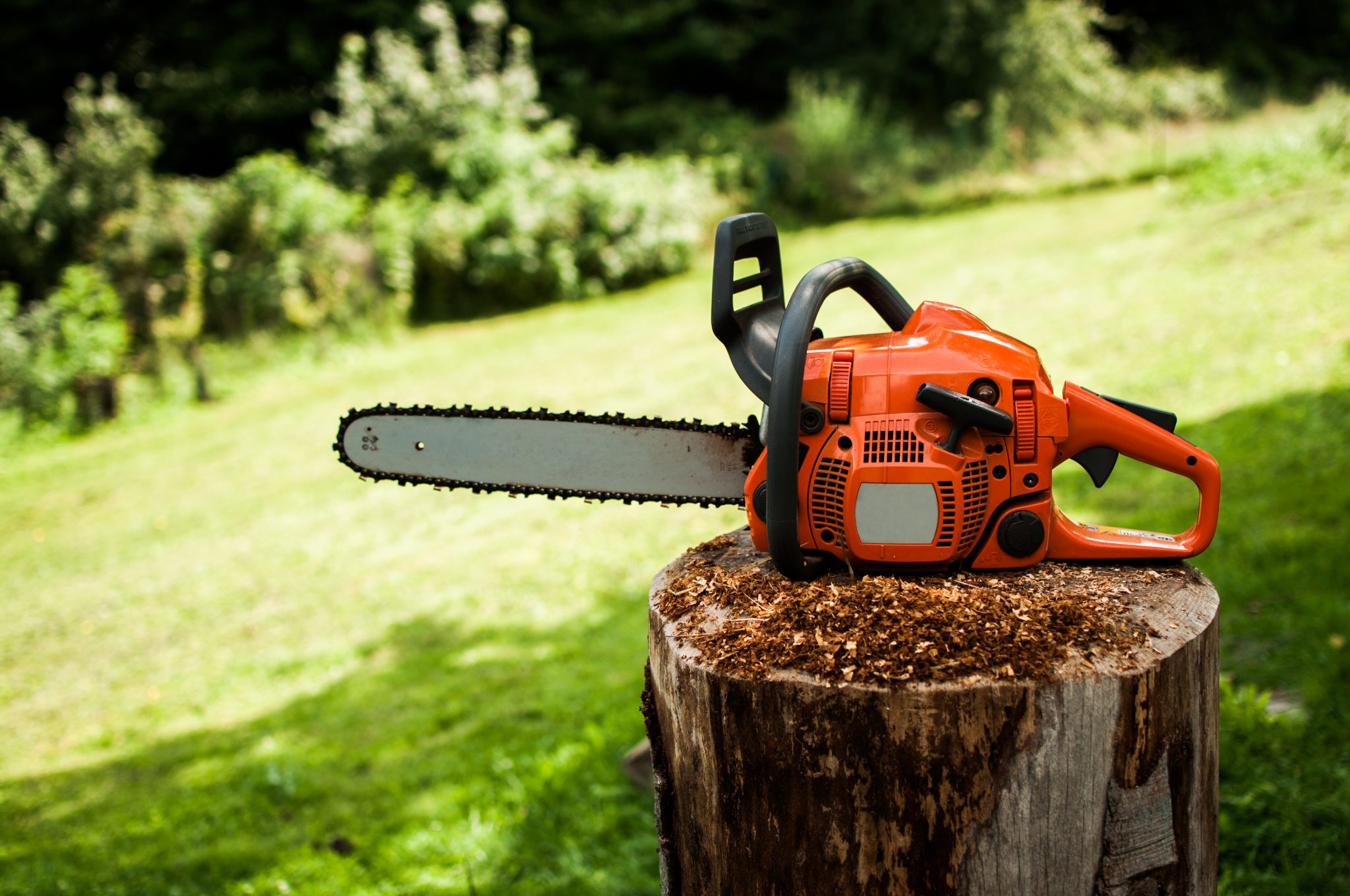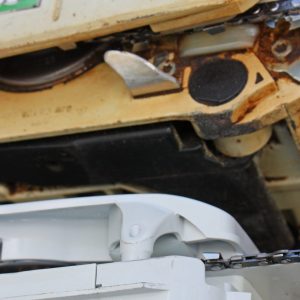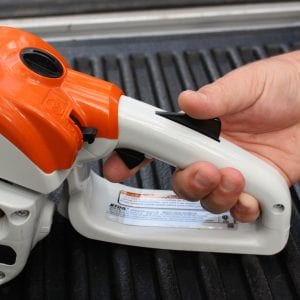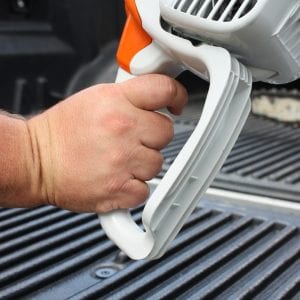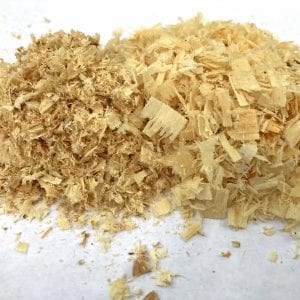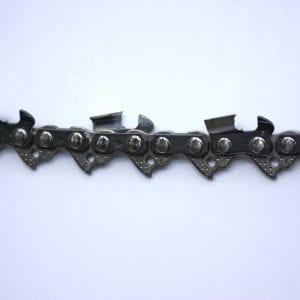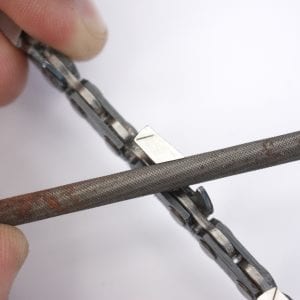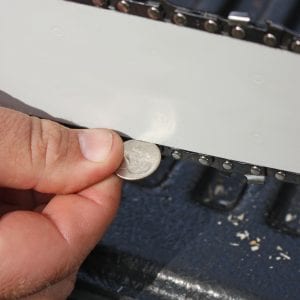Forestry

Each year more than 3 million chainsaws are sold in the United States to users with a variety of skills and experience. This inherently dangerous piece of equipment, combined with hazardous cutting situations and lack of personal protective equipment, contribute to more than 36,000 injuries each year. Understanding the saw’s safety features and function is the first step in proper chainsaw operation and risk reduction.
Chainsaws are frequently used by both trained professionals and private individuals with little or no experience. Although this versatile piece of equipment can be used in a variety of situations from pruning to post-storm cleanup, experience and training do not diminish the associated risks. The modern chainsaw design has incorporated features to improve operator safety, but it remains an inherently dangerous tool because of human error. Learn to select the right saw for the job, ensure that all of the saw’s safety features are functioning, and review the basics of chainsaw maintenance.
Selecting the Saw
Before purchasing or using a chainsaw, evaluate the job to determine the best size saw to accomplish the task. Avoid automatically selecting large, heavy saws. The larger the saw, the heavier it gets and the greater the risk of increasing user fatigue and injury later in the day. Modern saws are powerful, and a smaller saw is often all you need for jobs around the yard or farm.
Using a lightweight saw with a guide bar between 8 and 15 inches is appropriate for light-duty work such as cutting small limbs and trees. If the task involves frequent cutting of thick limbs and trunks, a midweight saw with a 16- to 20-inch bar is appropriate (figure1). Chainsaws with over 20-inch guide bars are typically considered professional-grade saws and not recommended for homeowners.
Keep in mind that the longer the guide bar, the more awkward the saw will be to use. Large increases in bar length require higher engine output that increases saw weight. Before changing the bar size on a saw, check the owner’s manual for bar lengths that are appropriate for your specific chainsaw.
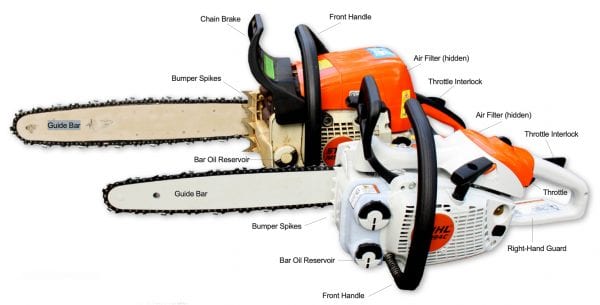
Figure 1. Chainsaw with safety features highlighted.
Chainsaw Safety Features
Modern chainsaws have numerous safety features that significantly mitigate the risk of injury. If these features are not in proper working order, the operator must not use the saw and should send it for repairs. The safety features and their benefits to the operator are as follow:
Chain Brake. When engaged, the chain brake will immediately stop the rotation of the chain around the bar (figure 2). Chain brakes can be engaged either by pushing the handguard forward or by inertia from a rotational kickback. Chain brakes must be engaged before starting the chainsaw. Chain brakes must also be engaged if the user is taking more than two steps while the saw is turned on. If you are moving a distance more than two steps, consider turning off the saw and restarting when you get there.
Chain Catcher. Constructed of metal or plastic, the chain catcher is found on the underside of the saw near where the chain enters the body of the saw engine housing (figure 3). The chain catcher is designed to catch and stop a chain that has broken or become disengaged with the guide bar. Ensure that this piece is fully intact and not worn down or broken before operating the saw.
Spark Arrestor. This is part of the exhaust system and helps prevent sparks from leaving the saw and creating fires. Located under the muffler cover, this rectangular mesh screen, which can get clogged by dirt, sawdust, and carbon buildup, prevents exhaust from leaving. The engine will not run if the spark arrestor is blocked, and it should be cleaned with carburetor cleaner fluid or replaced. Make sure that the muffler has cooled before removing to clean the spark arrestor.
- Figure 2. Chain brake.
- Figure 3. Chain catcher.
- Figure 4. Trigger and throttle interlock.
Vibration Reduction System. This standard component on all modern chainsaws consists of springs and rubber bushings that connect the saw front and rear handles to the engine and guide bar. The design helps absorb shock and dampen vibration from the saw. This will limit stress and fatigue on the user’s hands, arms, and joints that can result in long-term damage to the user.
Trigger and Throttle Interlock. Located on the rear handle of the saw, the trigger and throttle interlock helps prevent the throttle button from being engaged until the interlock is depressed with the operator’s right thumb (figure 4). This prevents brush or a stick from inadvertently engaging the throttle when the operator is not ready.
Right-Hand Guard. This plastic guard forms the bottom of the rear handle and protects the operator’s hand from being struck by a broken or disengaged chain (figure 5).
Muffler. Like all gas-powered engines, the muffler reduces noise and directs exhaust away from the operator. The chainsaw muffler should not be touched, as the temperature can exceed 900 degrees F and cause severe burns.
Centrifugal Clutch. The centrifugal clutch is the connection between the engine drive shaft and the chain sprocket. When the engine is idle, the clutch disengages and causes the chain to stop spinning. When the throttle is depressed, the clutch reengages the sprocket and driveshaft, and the chain begins spinning.
Bumper Spikes. Also referred to as felling dogs, these metal spikes are located where the guide bar meets the power head (figure 6). These metal spikes are designed to grip the wood and reduce rotational kickback or push-pull reactive forces. Bumper spikes should be in contact with the tree, when cutting, to maximize their effectiveness.
- Figure 5. Right-hand guard.
- Figure 6. Bumper spikes.
- Figure 7. Wood components from a dull chain will be a fine sawdust (left). A sharp chain will have wood shavings (right).
Chainsaw Maintenance
A properly maintained saw is essential not just to keeping your saw functioning correctly and efficiently but also to mitigating risk associated with operating a chainsaw. Refer to the owner’s manual, and follow the manufacturer’s recommendations for service and maintenance. Components and saw parts frequently needing maintenance follow. Check these components before operating a chainsaw.
Chain Sharpness. Always use a properly sharpened chain. Dull chains decrease cutting efficiency making operators work harder and grow tired faster. Dull chains also increase the risk of injury. They cause operators to press down harder on the saw, increasing the saw’s reaction forces and often putting the operator at greater risk. Dull chains produce fine sawdust and sometimes smoking wood (figure 7). When performing maintenance on the chain, wear gloves to reduce the risk of being cut.
A chainsaw chain is divided into two parts, the cutter tooth and the drive link, connected by rivets (figure 8). The cutter tooth link has a top plate that shaves off a slice of wood while cutting. The depth gauge on the cutter tooth controls the amount of wood material removed. The drive links go into the guide bar groove and move the chain.
Chains should be sharpened to manufacturer’s guidelines and with the appropriate file size for the chain being used. Follow the filing angle side on the chain tooth and file the depth gauge as needed to ensure that the proper amount of wood is planed off when cutting (figure 9). Filing too much of the depth gauge will result in the tooth removing too much wood and binding up.
Chain Tension. Proper chain tension on the bar is important to ensure that the drive links are properly engaged on all sides. This ensures that the chain speed remains constant and reduces the likelihood that the chain could disengage completely from the guide bar. Methods for tightening a chain can vary among saw models, so refer to the saw’s user manual for guidance. Proper chain tension should only allow a dime’s width between the chain guide bar and the chain (figure 10).
- Figure 8. Parts of a chainsaw chain.
- Figure 9. Filing chain.
- Figure 10. Proper chain tension.
Guide Bar Maintenance. The guide bar should be checked and cleaned when performing maintenance on the chain. Ensure that the guide bar does not have any damage or burs that could interfere with the chain’s rotation. Also, clean the grooves and oil holes of any grime or debris. Over time, the guide bar may begin to wear; therefore, a good practice is flipping the guide bar over each time the chain is changed. Specific tools for guide bar maintenance are available and recommended.
Bar Oil. Always check the bar oil levels before using the chainsaw and periodically during extensive use. Bar oil is a specially formulated, high viscosity, and high tack oil designed to not be slung off as the chain rotates around the guide. Because of this, it is important to use chain bar oil instead of other oils to lubricate the bar.
Fueling the Saw. Most modern chainsaws have a 2-stroke engine that requires the user to mix fuel and oil in the same reservoir. The user manual for the saw will explain the gasoline and oil mixture ratio. The majority of commercially available saws use a 50:1 ratio, which means 2.6 ounces of oil to be mixed with 1 gallon of gasoline.
When fueling a chainsaw, use a well-ventilated area away from open flames. Clean up any spillage on the ground or saw before starting the saw. Manufacturers typically suggest using a minimum 89 octane gasoline that is ethanol free. If ethanol-free gasoline is not available, use 89 octane gasoline that contains less than 10 percent ethanol. You should also drain the fuel from the saw and run it empty (allow saw to run until it shuts off) if it is going to be stored for long periods.

Figure 11. Air filter.
Air Filters. Check the saw’s air filter should periodically to ensure that it is clean. Over time, dirt and sawdust will build up on the air filter reducing the engine’s efficiency and power and increasing fuel consumption (figure 11). Follow the manufacturer’s recommendations when cleaning the air filter. Most filters can be cleaned by using a soft-bristle brush to remove any large debris and then washing with mild soap and water before allowing the filter to air dry. If using compressed air, blow the opposite of the air intake, but beware that compressed air can cause holes in the air filter. Replace any damaged filters.
Closing
Before operating a chainsaw, the operator must understand the risks, functionality, and safety features of the saw. Operators should also incorporate personal protective equipment (PPE) for themselves and any others that will be working near the operator. The proper operation of a chainsaw and the use of PPE will not eliminate all risk, but they will reduce the chance of serious injury.
Download a PDF of Chainsaw Safety: Safety Features and Maintenance, FOR-2084.


